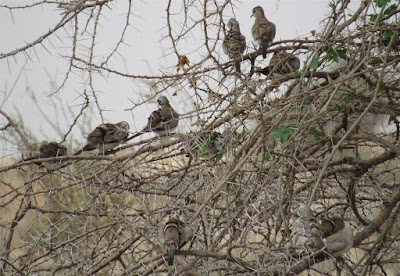Although the entrance to Diawling National Park is only 30 minutes further on from Keur Macene, the two places are connected by a road which is almost as bad as the main Nouakchott-Rosso road. This makes Diawling just too far for a day trip from Nouakchott even with the 6 a.m start we made.
There are a few large water birds that only Diawling National Park or the area around the border crossing at Diema can give. These are most notably lesser flamingo and pink-backed pelican. Neither are yet on my country list.
The question was, other than these two, can Keur Macene provide the same water birds as Diawling? Well, from yesterday's blog you can see I saw no yellow-billed stork, Marabou stork or giant kingfisher. Of course we could just have been unlucky. So they are still not yet on my country list.
However, looking at woodland birds we did much better.
I reported on the dideric cuckoo, seen on the way out, in the last blog.
On the way back home, we stopped three times within 15 kilometres of Keur Macene at places which looked like the most natural woodland habitat.
white-throated bee-eater
The best stop was 13 kilometres out of the town. However before then we had stopped 9 kilometres out. A typical bird was white-throated bee-eater there but the special one was dark chanting goshawk. We flushed a pair as we walked around.
dark chanting goshawk
This is classically one of the target woodland birds of visitors to Diawling. It was my first sighting in Mauritania.
beautiful sunbird
In the woodland at the 13 kilometre marker, the diversity of birds was good. There was a high density of beautiful sunbird. This appears to be the favoured host for Klaas cuckoo in Mauritania. Indeed we saw two cuckoos fighting over head but which moved off too fast for us to be assured that they were Klaas cuckoo rather than Dideric cuckoo. The former is extremely likely but not at a high enough confidence level for me to add to the list.
buffalo weaver
Also at the same place were buffalo weaver, Vitelline masked weaver and the only red-billed quelea of the trip. All three species were in breeding plumage.
Buffalo weaver was one of three different essentially black birds observed at there. The other two were black bush robin and northern ant-eater chat.
Tawny-flanked prinia
We had been hearing prinia calls all day in different places. It was only here that I finally saw one. It was the expected tawny-flanked prinia.
More generally, small passerines were difficult to locate all day. Two others seen were northern crombec and a migrant spectacled warbler.
greater blue-eared starling
The dominant starling of this area is greater blue-eared starling.
grey-headed kingfisher 1
grey-headed kingfisher
Based on the sightings of dideric cuckoo, grey-headed kingfisher and dark chanting goshawk, it appears it is not necessay to go as far south as Diawling for most of the National Park's woodland birds. Some large water birds and small land-based passerines such as quailfinch and African stonechat are another issue.
Overall, it had been a successful day and much was learned about the range of some birds.
Species seen North East of Keur Macene
Dark Chanting-Goshawk
Laughing Dove
Namaqua Dove
Dideric Cuckoo
Western Red-billed Hornbill
Grey-headed Kingfisher
White-throated Bee-eater
Blue-cheeked Bee-eater
Abyssinian Roller
Woodchat Shrike
Pied Crow
Chestnut-backed Sparrow-Lark
Black-crowned Sparrow-Lark
Crested Lark
Barn Swallow
Northern Crombec
Spectacled Warbler
Black Scrub-Robin
Northern Anteater-Chat
Greater Blue-eared Starling
Yellow-billed Oxpecker
Beautiful Sunbird
White-billed Buffalo-Weaver
Vitelline Masked-Weaver
Red-billed Quelea
































































